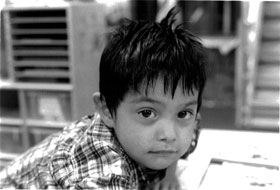On paper, Augsburg College looks a lot like most other liberal arts colleges. We have similar courses, departments, and programs. We teach students to think critically and to lead responsibly in the world, which is what other schools also aim to do. And our students, staff, and faculty don’t look much different than those at the big school across the street or the small campuses across the river.
But in person we look and act differently. At Augsburg, we try to put our own creative spin on things and to look at issues from different perspectives.
For example, this year some of our first-year students and a group of faculty spent an entire semester working together on a big problem in our first “I-Term.” In another example, students in the Honors program create their very own courses, write and edit their own scholarly journal, and together shape their own learning environment. And, one of our alums has found a very creative way to do community service while also running a thriving business.
The stories in this issue represent just a few of the “out-of-the-box” programs, people, and partnerships that make us uniquely Augsburg.
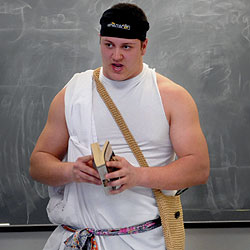 |
HONORS — The Honors program consists of a combination of classes, students, structure, and a whole lot of creativity. Read the story > |
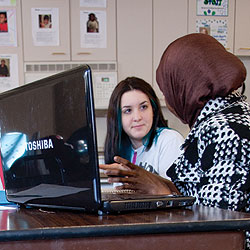 |
NEIGHBORHOOD — Working closely with Cedar-Riverside and Seward residents is just one of the ways we live out our vocation to serve our neighbors. Read the story > |
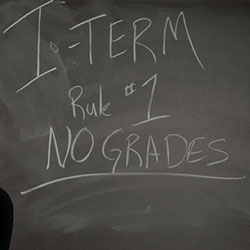 |
I-TERM — 50 students, 5 professors, 1 big problem. Last fall’s I-Term students discussed three big challenges in the non-graded Fate of the Earth course. Read their story > |
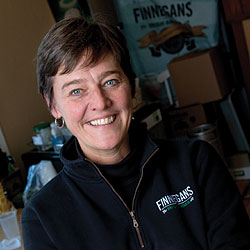 |
FINNEGANS — As a student, Jacquie Berglund ’87 dreamed of helping the working poor. Today her sense of vocation drives her to take leaps of faith that make life better for others. Read her story > |
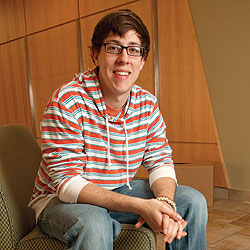 |
IGNITE — What’s a great way to engage alumni? Introduce them to current students who have similar majors or interests and let them swap stories. In the end, everyone benefits. Read the story > |
Online exclusive: More out-of-the-box partnerships
Arts and culture
In the past year, assistant art professor Susan Boecher has developed a deep partnership with Centro, a Minneapolis-based social service organization providing education, health and wellness, and arts and culture services for the metropolitan Chicano and Latino communities. Boecher became active with Centro when her fall 2009 Fine Arts Keystone class—which included students from film, theatre, music and studio arts—developed and presented “Finding Centro,” a collaborative art piece based on their service experience at Centro. The performance piece was presented last December on campus and to Centro clients and staff at Cento’s Chicago Avenue location. The performance at Centro was held in conjunction with a silent auction of student work to raise money in support of the organization. For spring 2010 semester 2010, Boecher developed a community-based photography course that required students to create a portfolio of work based on their service experiences at Centro. At the end of the term, students presented their portfolios to staff, volunteers, elders and children at Centro and also provided a CD of the portfolio materials for Centro to use in its promotional and capacity-building efforts. Boecher will continue her relationship with Centro this summer when she will teach a 5-week photography workshop for Augsburg photography students and Centro teens from the Raices program.
The Centro projects are not the first time Boecher has connected student learning with community engagement. Last summer Boecher conducted a photo workshop that partnered Augsburg students with a group of teens from the local Karen community. The 5-week class taught skills needed to expose, develop, and print black and white film, and encouraged students to spend time together outside of class. Students attended youth picnics, church services, a local concert, and a Karen wedding. An exhibition of the completed work, “With Our Eyes,” was showcased in the Oren Gateway Gallery as part of the Nobel Peace Prize forum in March.
International space physics research
In seven of the past 10 years, Russian physicist Viacheslav (Slava) Pilipenko has traveled to Augsburg College to spend a semester conducting research, teaching physics courses and collaborating with Augsburg students and faculty in the area of space physics.
Pilipenko first met Augsburg physics professor Mark Engebretsen at a space physics conference in Vancouver and, through funding from the National Science Foundation, the two began a decade of collaborative research on the aurora borealis and geomagnetic storms. Specifically, their research has focused on the effects that ultra-low frequency (ULF) waves may have in triggering radiation storms in the Earth’s magnetosphere—activity that makes the aurora visible to humans on land and can also disrupt electronic communication, interfere with navigation systems and even damage orbiting satellites.
In Moscow, Pilipenko is head of the laboratory for ULF waves at the Institute of the Physics of the Earth and also holds an appointed position at the internationally recognized Space Research Institute, giving him a valuable perspective in studying Earth’s space environment. Pilipenko will return to Augsburg for the spring semester 2011 to continue his work with Augsburg students and faculty.
Partnerships in Central America
For more than 15 years, the Center for Global Education (CGE) at Augsburg College has partnered with the Winds of Peace Foundation (WPF) in Nicaragua, supporting its efforts to raise awareness of and alleviate social, economic and civil inequalities in the country. The foundation uses a combination of lending and grant making to indigenous communities, women’s groups and the rural poor to assist them in improving their circumstances through their own efforts.
Mark Lester, co-director of CGE’s permanent site in Nicaragua and longtime resident in the country, serves as the Winds of Peace Foundation’s field director, identifying programs for WPF funding that foster sustainable self- and community development. Having permanent staff in the country helps the foundation maintain consistency and accountability in its giving and provides a resource for grant and loan recipients.
The results of the program included significant and long-term improvements in the social infrastructure of communities, with residents taking on leadership roles and new responsibilities for the common good.
The Center for Global Education has also extended the reach of its Central American programs through a partnership with the Ignatian Colleagues Program (ICP), a collaborative venture of 27 Jesuit colleges and university and sponsoring provinces. Through this partnership, CGE provides the international component of the program’s orientation for deans, vice presidents and other top administrators. To date, CGE has conducted three immersion programs in El Salvador for the ICP and will hold another in Nicaragua this summer.
“The Jesuit colleges and universities are striving to ensure their leadership understands social justice in a global sense,” Lestor said. “Because of our similar mission and our locations in developing areas of El Salvador, Nicaragua and Guatemala, the Center for Global Education is a good fit for them.”
CGE also has long-standing relationships with a number of individual Jesuit universities, having conducted more than a dozen immersion programs for professors and senior administration officials from Seattle University, Boston College and the University of San Francisco over the years.
Partners close to home
Augsburg has long-term partnerships with numerous organizations surrounding our campus locations–partnerships that benefit Augsburg not only by providing ways we can support our communities but also by offering excellent learning experiences for our students and giving faculty the opportunity to collaborate with practitioners in the field on current issues in their disciplines.
Three such partnerships near our main campus are the Brian Coyle Community Center, the East African Women’s Center and the Seward Montessori school.
The Brian Coyle Community Center serves the Cedar-Riverside neighborhood of Minneapolis, one of the most densely populated areas in the state. The neighborhood center provides a highly accessible entry point to the social service system as well as a gathering place for neighborhood residents.
Programs at the Coyle Center are run by Pillsbury United Communities (PUC), a nonprofit organization with centers in several Minneapolis inner city neighborhoods. Over the years, the Augsburg community has partnered with PUC to provide many projects and services at the Coyle Center, including:
- Establishing a scholarship program allowing Coyle Center youth to pursue a college education at Augsburg
- Placing student interns and providing considerable staff and faculty volunteer hours at the center
- Supporting Campus Kitchen involvement at the center
- Donating cash and in-kind items through efforts such as Augsburg’s annual “Foodless Food Drive” that helps replenish supplies in the Bryan Coyle Community Center Food Shelf
Just around the corner from the Coyle Center is the East African Women’s Center (EAWC), where Augsburg has been active for several years. The center is designed to assist Somali women and girls across generations in navigating American systems and making the transition to life in the U.S. while still preserving their traditions.
Since the center opened in 2005, Augsburg students, staff and faculty have devoted countless hours of volunteer time to the center—doing everything from painting and handyman repairs to conducting on-campus tutoring sessions for Somali high school students to working side-by-side with Somali women learning to cook and sew.
Augsburg even gave the Women’s Center a “kitchen shower,” a project initiated by Mary Laurel True, Augsburg’s director of service learning and community engagement and member of the EAWC advisory council. Through this initiative, students in a religion class taught by professor Bev Stratton sought donations from the Augsburg community and purchased items for the Women’s Center kitchen based on a wish list provided by women at the center. The donations also included cash and gift cards to Target and Ikea so that the East African women could take an active part in shopping to equip the center’s kitchen.
Across Interstate 94 from Augsburg College is the Seward Montessori school, which serves more than 800 students from Kindergarten through 8th grade. Augsburg’s 15-year partnership with Seward Montessori has resulted in several initiatives engaging Augsburg students with Seward students and teachers. Two of the key programs are Augsburg’s Bonner Leadership Program, in which students make a commitment to work in the community 8 to 10 hours per week for a minimum of two years, and the Augsburg Reads program, which is a campus work study program involving Augsburg students assisting teachers in their classrooms.
Augsburg also involved the entire 7th grade class of Seward Montessori in last summer’s Augsburg Day of Service by having the Seward students work side-by-side with Augsburg volunteers in the Augsburg community garden, the Korean Peace Garden and in clean-up efforts at the Bedlam Theatre.
In addition to the student engagement initiatives, Augsburg offers a scholarship to Seward students who attend Augsburg—$1,000 for each year the student attended Seward—encouraging area students to come to Augsburg and laying the groundwork for strong connections between the college and the neighborhood far into the future.


